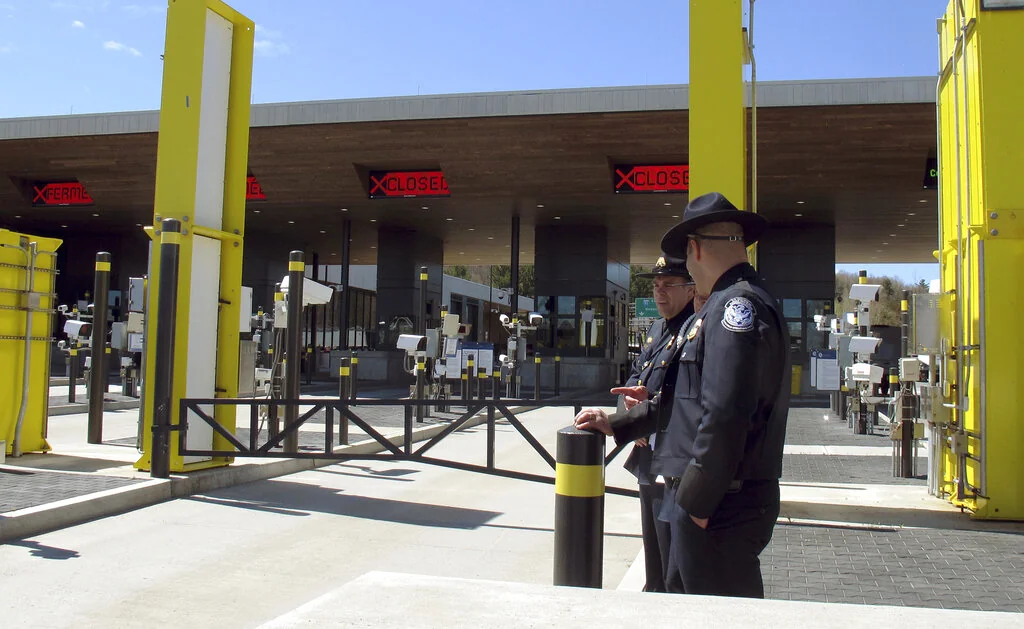President Donald Trump declared a state of emergency this year for the northern border for human smuggling and drug trafficking. While the nearly 4,000-mile-long border with Canada gets less attention than the high-volume southern border, the boundary presents its own set of challenges. The Washington Examiner visited the northern border to evaluate how security has changed under the new administration for the series Threats from Up North: Patrolling the U.S.-Canada Border. Part 2 is on drug smuggling across the northern border.
CHAMPLAIN, New York — Drug smuggling across the U.S.-Canada border is a top concern for federal law enforcement during the Trump administration, and police officials have said their partnership with Canadian officials is reaping benefits.
President Donald Trump has spotlighted securing the northern border since he returned to office in January. The Trump administration went as far as imposing tariffs on Canada until the country took greater action to address the southbound flow of fentanyl.
Canada has worked hand-in-hand with the United States to address the flow of drugs, which the recent decline in the amount of narcotics seized at the border supports, the Washington Examiner learned from conversations with a northern border congresswoman, the Canadian border agency, and U.S. Customs and Border Protection officials during a ride-along in upstate New York in mid-May.
“Fentanyl across the border is coming down,” said Rep. Claudia Tenney (R-NY), whose district neighbors Canada. “I’ve been speaking recently with [White House border czar] Tom Homan and the Canadian government. The police up there, the Mounties, they’re interested in working on and bolstering the border, and they’ve been investing money into making sure that we have more cooperation and it’s a more secure border between the U.S. and Canada.”
Is Canada at fault?
Trump’s Feb. 1 executive order said Canada was “failing to devote sufficient attention and resources or meaningfully coordinate with the United States law enforcement partners to effectively stem the tide of illicit drugs.”
“Despite a North American dialogue on the public health impacts of illicit drugs since 2016, Canadian officials have acknowledged that the problem has only grown,” the executive order said.
CBP is responsible for inspecting all people and goods entering the U.S. Drugs are seized in one of two places: between the ports of entry or at the ports, including from pedestrians, passenger vehicles, commercial trucks, and cargo or international mail.
Despite the northern border being twice as long with twice as many crossings as the southern border, the U.S.-Mexico border sees more pounds of drugs interdicted than the northern border. In fiscal 2025, which began last October and was last updated through April, southern border officers seized 133,000 pounds of drugs compared to 6,000 pounds up north, CBP data show for the six-month period.
During fiscal 2023, under former President Joe Biden, drug seizures were at 55,000 pounds at the northern border. The numbers have remained at historic lows under Trump.
This speaks to fewer smuggling attempts, according to Judson Murdock, acting deputy executive assistant commissioner for CBP’s land ports of entry.
“I attribute that to deterrence,” Murdock said. “We are able to focus more on the threat. The cartels know that we are working with intensity, as well as the Canadians.”
In the first seven months of fiscal 2025, 7,400 pounds of fentanyl were seized at the U.S.-Mexico border, compared to 26 pounds on the Canadian border, according to CBP statistics.
Hilton Beckham, a Trump appointee who serves as CBP’s assistant commissioner of public affairs, said that although fewer drugs and fentanyl are seized coming in from Canada, any amount is unacceptable given the danger it presents to Americans.
“You can’t assess the threat at the Northern border simply by comparing it to the Southern border in terms of pounds seized. Just because the volume is lower doesn’t mean the threat is any less serious,” Beckham said in a statement. “Even 2 milligrams of fentanyl can be lethal — and we treat every seizure, large or small, as a critical disruption to transnational criminal networks. This is a public health and public safety crisis, and we are committed to using every tool we have to confront it — on both borders.”
If you try to make a wish with these candles, it likely will not come true. @CBP Officers at the Port of Buffalo intercepted Oxycodone pills being smuggled inside a shipment of candles. #OFOProud
#CBPBuffaloFO pic.twitter.com/GIoky4LuKF
— Buffalo DFO Rose Brophy (@DFOBuffalo) March 8, 2025
Drugs caught at border
The majority of the drugs seized at both borders are meth, marijuana, and cocaine.
In general, cocaine and methamphetamine move north into Canada after transiting the U.S. from Mexico. Fentanyl, marijuana, and ecstasy flow south from Canada into the U.S. The same Mexican drug cartels that produce and facilitate drug smuggling are involved at the northern border, along with crime rings involved in bootlegging during Prohibition.
CBP’s Detroit Field Office leads the nation in pounds of drugs seized in fiscal 2025, with cocaine making up 80% of all drugs seized.
Detroit’s Ambassador Bridge is the northern border’s busiest truck crossing, where drugs are often concealed in large containers coming across the border in commercial cargo.
At this bridge, drugs are not only caught flowing south into the U.S., but more drugs are caught by criminals attempting to move them north into Canada after being smuggled through the U.S. from Latin American countries, according to CBP’s Detroit Port Director Marc Calixte.
“The goal is for us to disrupt, dismantle, and destroy criminal organizations. If you’re crossing the port, inbound and outbound, if you are involved in narco-trafficking, if you are involved in any illegal activity, our job is to stop that,” Calixte said in an interview.
Last month, officers at the Ambassador Bridge stopped a truck carrying 339 pounds of cocaine northbound into Canada.
Calixte said it is still his officers’ responsibility to stop the flow of drugs, even though it is heading out of the country.
SEIZED: @CBP officers intercepted 339lbs (154kgs) of cocaine during outbound operations at the #AmbassadorBridge in #Detroit, April 15. The driver–an Indian citizen–was arrested and faces federal prosecution.
Learn more
https://t.co/dBFjoAYF01 pic.twitter.com/8K4cwnqv5O
— DFO Marty C. Raybon (@DFODetroit) April 17, 2025
Canada’s work
Canada was working to stop the flow of fentanyl and synthetic opioids into the U.S. before Trump took office. It has since appointed a border czar to focus on the problem.
The Canadian government announced days before Trump took office that it had arrested more than 500 people and seized 101 pounds of fentanyl and 15,000 pills of fentanyl and other opioids, according to a statement from the Royal Canadian Mounted Police on Feb. 26.
The Canada Border Services Agency told the Washington Examiner that it recently concluded Operation Blizzard, a cross-country initiative to intercept illegal goods and drugs heading into and out of Canada.
CBP officials who spoke with the Washington Examiner insisted that Canada has been and continues to be a significant partner on law enforcement matters, including combating drug smuggling.
“Our information-sharing agreements with our Canadian counterparts absolutely help us protect our borders,” Murdock said.
Trump’s targeting of Canada for new tariffs and citing fentanyl trafficking as the rationale drew bipartisan skepticism, particularly given the unaddressed demand side of the epidemic.
Senate Democrats and even several Republicans have come to Canada’s defense and knocked the Trump administration for going after it so severely, given the long history of cooperation.
Simon Hankinson, senior research fellow at the conservative Heritage Foundation’s Border Security and Immigration Center in Washington, D.C., maintained that there is a growing problem in Canada.
“I have spoken to Canadian officials recently a few times, and they seem to think they are making progress. But there are a lot of labs making drugs, and more ready-made fentanyl coming into Canada and being consumed locally or shipped south to us via trucks,” Hankinson said in a March email.

The Trump administration’s ability to clamp down on fentanyl and other drugs coming over the southern border has put more pressure on Mexican drug cartels to find other ways to get narcotics into the U.S.
A May report by the Drug Enforcement Administration concluded that “super laboratories” for fentanyl production were recently uncovered in Canada, drawing more concern about how cartels may be planning to move their product into the U.S.
A spokesman for the Canadian border agency maintained that Canada was funding its border security plan and would work closely with the U.S. to safeguard both countries’ interests.
“We have a strong border, and we are making it stronger,” a CBSA spokesman said. “Canada’s Border Plan is backed by an investment of $1.3 billion to bolster border security, strengthen our immigration system, and contribute to Canada’s prosperity.”
MOST ILLEGAL IMMIGRANTS ARRESTED NEAR CANADIAN BORDER ENTERED FROM MEXICO
Tenney said Trump’s focus on the matter already had a positive effect deterring crime rings at the border, but that it would continue to be met with enhanced cooperation from Canada.
“The level they’re interested in investing, from what I’ve heard, is going to be significant, and that will, you know, be a very big bonus to us on the northern border, and really limit the kinds of fentanyl, and other illicit drugs that are coming across the border,” Tenney said.























